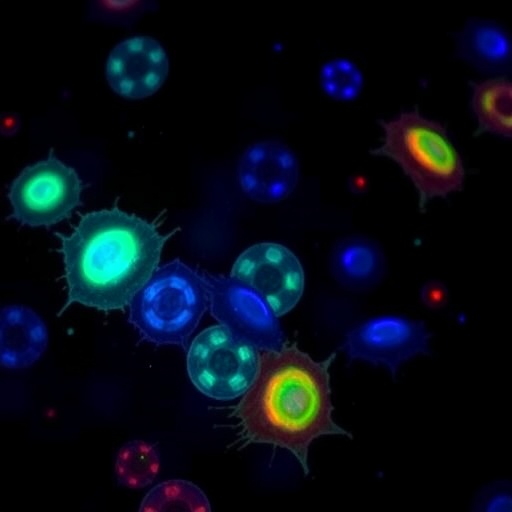In an extraordinary scientific development, researchers from the University of Malaga’s Departments of Physical Chemistry and Organic Chemistry, in collaboration with the Biomimetic Dendrimers and Photonic Laboratory at the IBIMA Plataforma BIONAND research institute, have unveiled a new class of fluorescent molecules poised to revolutionize cellular imaging and biomedical diagnostics. This groundbreaking advance merges the disciplines of materials science and biomedicine, giving rise to molecules that defy conventional wisdom by increasing fluorescence intensity in aqueous environments rather than diminishing it.
Traditionally, fluorescent dyes experience a decline in brightness or shift to less vibrant hues when introduced into water or other biological media, which hampers their utility in live-cell imaging. However, the novel fluorescent compounds synthesized by this multidisciplinary team exhibit an unusual, counterintuitive phenomenon: they intensify their fluorescence and shift their emission spectrum towards the blue region upon dissolving in water. This remarkable blue shift enhances their luminescent properties exactly where clarity and precision are most critical—in the aqueous interior of living cells.
The implications of this discovery are profound. The enhanced fluorescence in a biologically relevant medium means these molecules can illuminate cellular structures with unprecedented brightness and accuracy. One of the most compelling applications is in the field of multiphoton microscopy, a sophisticated imaging technique that enables researchers to visualize living tissues deep beneath the surface without causing cellular damage. By utilizing these new dyes, scientists can produce clearer, safer, and more detailed images of cells, advancing the study of complex biological processes.
A particularly striking characteristic of these molecules is their selective affinity for mitochondria, the cellular organelles known as the “powerhouses” due to their critical role in energy production. Mitochondrial dysfunction is implicated in a spectrum of diseases, including cancer and neurodegenerative disorders, making precise visualization of these organelles essential for early diagnosis and therapeutic monitoring. The ability to selectively highlight mitochondria with these dyes represents a significant leap towards more effective biomedical imaging protocols.
These fluorescent molecules not only excel in performance but also offer practical advantages over existing dyes. The researchers emphasize their relatively straightforward and cost-effective synthesis compared to traditional fluorescence agents, which often involve complex and expensive manufacturing processes. The accessibility of these compounds paves the way for widespread adoption in biomedical research labs, clinical diagnostics, and potentially even in therapeutic contexts where real-time cellular imaging is vital.
Central to this milestone is the concerted effort of a team led by Professors José Manuel Marín Beloqui, Juan T. López Navarrete, Juan Casado Cordón, Ezequiel Pérez-Inestrosa, Carlos Benítez Martín, and Francisco Nájera Albendín. Their expertise traverses the boundaries of chemistry and photonics, showcasing the power of interdisciplinary collaboration. The research has been recognized internationally, featured in the influential journal Advanced Materials as part of a special issue highlighting Spain’s foremost material science research groups.
Professor Ezequiel Pérez-Inestrosa highlighted the dual significance of their findings: “Our molecules challenge established fluorescent chemistry paradigms while simultaneously opening avenues to new diagnostic tools for diseases where mitochondrial function is critical.” Likewise, Professor Juan Casado praised the synergy between fundamental chemical insights and applied biomedical research that culminated in this discovery.
This achievement also honors the legacy of Professor Teodomiro López Navarrete, the current Rector of the University of Malaga, whose pioneering work in physical chemistry has been instrumental in establishing the foundation for such advanced materials research. His co-authorship underscores the continuity of scientific excellence and mentorship pivotal to this kind of innovation.
From a technical perspective, the molecular architecture of these dyes facilitates symmetry breaking that leads to dicationic bis(indolium) structures with robust two-photon absorption properties. This molecular configuration is essential for their enhanced near-infrared (NIR) fluorescence, enabling deeper tissue penetration during imaging and minimizing phototoxicity. The two-photon absorption capability also means these molecules can be excited using longer wavelengths, which are less damaging and allow for clearer visualization of cellular interiors.
The research team conducted extensive experimental analyses verifying the optical properties and biological compatibility of these fluorescent molecules. Their results demonstrated that these compounds maintain high fluorescence quantum yields in aqueous media, contrary to typical quenching effects seen in traditional dyes. Furthermore, live cell imaging experiments confirmed that the dyes integrate seamlessly within cellular environments without perturbing normal cellular function, a crucial factor for biomedical applicability.
The broader significance of this work lies in its potential to democratize advanced biophotonic imaging. By reducing costs and simplifying dye production without sacrificing image quality, this innovation could facilitate earlier and more accessible disease detection, monitoring, and research worldwide. The intersection of cutting-edge chemical design with practical biomedical utility heralds a new era in fluorescent probe technology.
Advancing the scientific landscape of Malaga and Spain, this research positions regional institutions at the forefront of global material science and biomedical development. It exemplifies how cross-disciplinary efforts can yield transformative tools that not only deepen our understanding of fundamental biology but also promise tangible improvements in healthcare diagnostics and treatments.
In conclusion, the University of Malaga and IBIMA Plataforma BIONAND’s breakthrough fluorescent molecules represent a paradigm shift in live-cell imaging. Their counterintuitive blue-shifting fluorescence, selective mitochondrial targeting, and ease of synthesis herald new possibilities in biomedical research and clinical diagnostics. The successful integration of materials science and biomedicine showcased in this study underscores the potent innovations emerging from multidisciplinary collaborations and sets a new benchmark for fluorescent probe development.
Subject of Research: Cells
Article Title: Counterintuitive Fluorescence Blue Shift in Symmetry Breaking Dicationic Bis(indolium) with Two-Photon Absorption Properties for NIR Living Cell Imaging
News Publication Date: 13-Sep-2025
Web References:
https://doi.org/10.1002/adma.202510730
References:
Benitez-Martin, C., Marin-Beloqui, J. M., López Navarrete, J. T., Casado, J., Najera, F., & Perez-Inestrosa, E. (2025). Counterintuitive fluorescence blue shift in symmetry breaking dicationic bis(indolium) with two-photon absorption properties for NIR living cell imaging. Advanced Materials.
Image Credits: University of Malaga
Keywords
Physical sciences, Chemistry, Molecular chemistry




